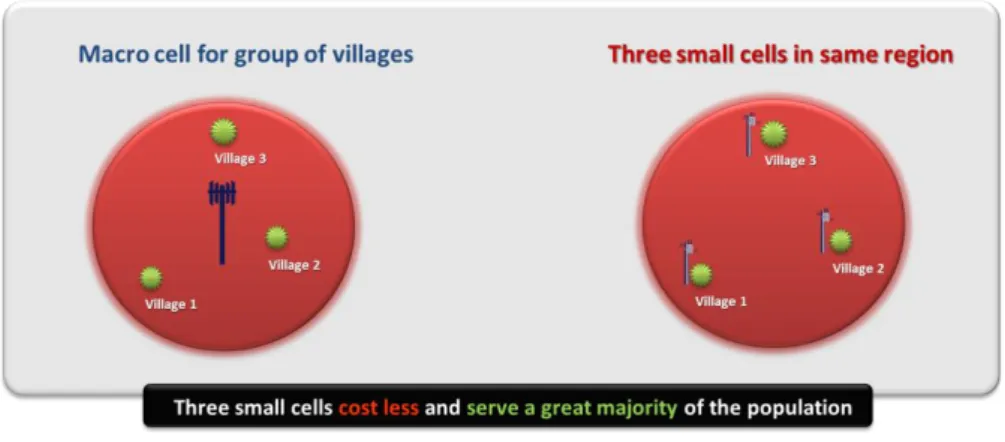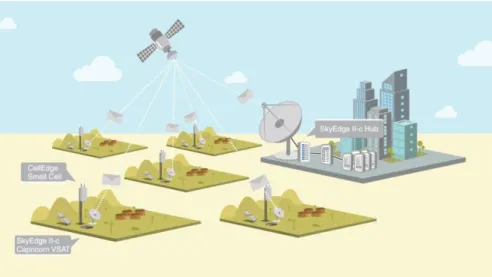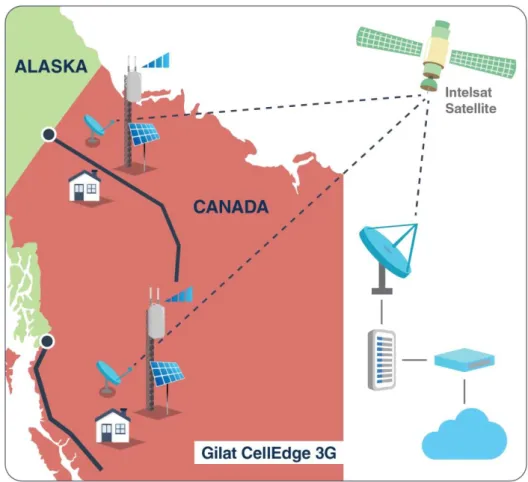Extending Mobile Networks
into Rural Areas via
Introduction
3
Shifting market demand
3
Importance of network diversification
3
Overview of backhaul routing
6
Integrated small cell / satellite backhaul solution
7
Revenue sharing model for satellite providers and MNOs
9
Case Studies
9
The mobile market has experienced a huge surge in growth across the globe. However, mobile networks operators (MNOs) are still struggling to extend coverage to rural areas due to lack of infrastructure. While it is often impractical and inefficient to extend mobile networks
terrestrially, the use of small cells and satellite technology offers a quick and cost-effective solution that makes rural connectivity worthwhile.
The mobile market has grown so rapidly that subscriptions in
developed areas are actually tapering off. Mobile penetration in cities is often over 100% meaning that there are more subscriptions than people. But there is one demographic which remains untapped in the global market: the nearly 2 billion potential customers who currently live beyond the reach of mobile networks in remote regions. Until recently, operators would not even attempt to reach rural subscribers for two reasons: (1) They could not justify the time and expense involved in rolling out conventional infrastructure; and (2) the projected average revenue per user (ARPU) was extremely low. But as urban markets reach saturation and as regulations often require mobile operators to provide a universal level of service, everywhere, rural
markets now represent the final frontier for continued growth.
When MNOs want to expand their networks, they instinctively think about using macro cells, with their high capacity and wide coverage. This is a natural response since most cellular networks are based on macro cells and operators already know how to deploy and operate them. But a single strategy to network expansion does not account for the nuances of data consumption patterns in rural areas.
Cellular networks often exclude rural areas due to low ARPU.
However, when operators are either required to extend their networks by service obligation, or determine that coverage is needed in a specific area for business reasons, they must still contend with the high cost of macro cells. Unless the target population has grown significantly, a macro cell deployment requires significant investment in terms of CAPEX and OPEX, which is hard to justify for a small rural enclave.
Introduction
Shifting market
demand
Importance of
network
diversification
Figure 1: Macrocell vs Small Cell in Same Region
The total cost of ownership (TCO) of a three-sector LTE macro-cell network, over a five-year period, is approximately $280,000. In
comparison, the TCO of a 3G small-cell network, over a similar period, is less than a sixth of this price (Senza Fili, 2012).
Even multiple small-cell deployments do not add up to the cost of a single macro cell deployment. Imagine a typical rural scenario: a village here, another village 20 kilometers down the road, and a third village 30 kilometers beyond that. Because rural residential areas are clustered around a few population centers, they are ideal candidates for a small cell solution, which can be deployed much more rapidly and at far less expense.
While macro cells remain the recognized building blocks of most cellular networks, a network architecture that incorporates a variety of methods, rather than adopting a one-size-fits-all approach, is more flexible and more likely to thrive.
Figure 2: Cellular Network System Architecture
Small cells are ideal for addressing the challenge of extending 2G/3G networks to outlying areas. Northern Sky Research forecasts that small cells will outnumber macro cells in rural sites by 2025. While small cells have their limitations, they are a useful complementary tool in the portfolio of a well-planned network. Particularly in rural markets, a small cell solution can be critical to success.
Small cells originally became known to the cellular industry as a solution for boosting coverage in urban areas, where higher
frequencies assigned to 3G networks could not penetrate buildings, thus hampering connectivity. To solve this problem, small cells were often situated on each floor of tall buildings. Recently, small cells have come to be regarded as a solution for sparsely populated rural villages as well, providing coverage within a three-kilometer radius. They represent an easy-to-implement solution for handling data, cost far less than macro cell deployments, and require little power to run.
The vast majority of cellular backhaul is routed through fiber lines or microwaves. These technologies have their place in a network, but as previously mentioned, a diverse approach is often a more healthy and cost-effective approach. Let us examine the backhaul delivery
methods used today:
Fiber lines are ideal for urban areas, where a single deployment facilitates backhaul for a large quantity of data. As data traffic spreads to more geographically remote areas, fiber becomes less and less cost-effective due to increasingly expensive deployment costs and a drastic reduction in usage. In rural areas, the sheer distance between locations, difficult terrain, trench construction and slow deployment makes fiber a highly unlikely backhaul option unless the fiber lines are already in place.
Microwave supports large quantities of data transmission, but also has its limitations. When the gap between coverage areas is large and unpopulated, it is not economically feasible to add towers to bridge the distance. And for many rural areas, such as rain forests or
mountainous regions, microwave is simply not an option because it requires line-of-sight.
Satellite communication has no topographic limitations, making it the only viable alternative when distance, terrain or line-of-sight issues negate other forms of backhaul. Although satellite might be more expensive than other solutions, it is scalable, highly reliable and can be deployed quickly, even under the most challenging geographical and climactic conditions.
Overview of
backhaul
routing
Fiber
Microwave
Satellite
Figure 3: Backhaul Alternatives
According to an NSR study, satellite backhaul will have a 4% share of the global backhaul market by 2021 and is expected to grow.
As discussed, a small cell solution is ideal for rural network extension and satellite backhaul is often the only feasible solution for rural connectivity. To be a truly cost-effective proposition, however, small cell technology must be fine-tuned to reduce both CAPEX and OPEX and to work efficiently with satellite backhaul. Addressing these issues, Gilat has applied its extensive experience in satellite communications to design a fully integrated package that combines small cell with satellite backhaul. Its CellEdge solution includes a SkyEdge II-c VSAT, installed in close proximity to the small cell, which transmits data to the core network via satellite backhaul. Small cell and satellite backhaul are two disparate technologies that are generally sold separately. A considerable integration and optimization effort was required for the solution to be cost-effective, work seamlessly, provide a superior user experience and consume less power.
Mixing and matching just any small cell with just any VSAT is liable to be ineffectual if not done properly. Gilat integration covers:
Efficient satellite resource allocation and reduction of protocol
overheads
Data acceleration of cellular protocol to ensure a high-quality
user experience
Integrated
small cell /
satellite
backhaul
solution
Quality of Service, including prioritizing signaling and voice over data
Minimizing roundtrip delay and jitter
Gilat’s SkyEdge II-c CellEdge resolves these issues, offering a fully integrated, comprehensively tested solution with voice optimization, data compression and performance acceleration.
Figure 4: CellEdge
CellEdge makes use of a fully outdoor small cell that is passively cooled, as opposed to a macro cell base station which requires shelter or air conditioning. Because the small cell is lightweight, it can be mounted on a low-cost pole or light tower. Power transmission is high while power consumption is low. The solution is power-efficient,
reliable and can be run at low cost, features that are important for rural areas.
The logistics involved in delivering energy to a rural site off the power grid can include expensive fuel truck journeys, impassable roads, fuel theft and extreme weather conditions. A low-power solution eliminates such concerns. Finally, the lack of overhead associated with CellEdge compared to macro cells is particularly attractive to network operators.
Another way small cell implementations are winning over customers is revenue sharing models that leverage existing infrastructure to
increase profits. When small cells are connected to a cellular network, satellite providers that already have a presence in rural areas, can provide cellular voice/data coverage to unserved areas. In return, they receive a share of the revenue from the resulting traffic.
From the satellite provider’s perspective, they can take advantage of unused bandwidth on existing infrastructure to provide additional services and earn additional revenue. From the MNO’s perspective, they are able to avoid the costs of network deployment and
maintenance while attracting traffic in areas where their local presence may otherwise have been economically unfeasible.
This increasingly popular business model has been successfully implemented in places such as Indonesia and several African countries.
The following are two examples of successful 3G network extension into rural areas implemented using small cells and satellite backhaul. The first case study – RuralCom of Canada – represents an
opportunity for a group of entrepreneurs to address an unmet market need. The second – TIM of Brazil – is an example of an obligation a cellular provider took upon itself in order to be eligible to bid for a large, state-wide network. It first had to agree to extend mobile services to less profitable rural areas. Both represent turnkey CellEdge
implementations in underpopulated areas where fiber or microwave deployments would have been significantly more expensive.
In western Canada, the Alaska Highway stretches 1,909 kilometers from Dawson Creek until the Alaskan border. Scattered along this road are communities of a few hundred residents or less. It is a main artery for tourists and, in the summer, this two-lane highway becomes quite crowded. Trucks, RVs, and construction sites can delay traffic for up to an hour. Until recently, this long, somewhat unpredictable road had no mobile coverage.
Revenue
sharing model
for satellite
providers and
MNOs
Case Studies
RuralCom, Canada
- Alaska Highway
RuralCom, a wholesale cellular carrier based in Vancouver, BC, looked for a way to provide an economical and sustainable solution to serve this long rural corridor. Initially, it considered a macrocell-based solution but quickly realized that a small cell solution would optimize coverage at a far lower cost.
Figure 5: CellEdge Implementation in Ruralcom
Today, Gilat’s CellEdge small-cell-over-satellite solution enables RuralCom to provide 3G HSPA+, including voice, SMS, MMS and data services, to both its subscribers as well as customers of other cellular operators. But getting the network up and running required a good deal of coordination between partners in diverse locations. The core
network and roaming arrangements were provided by a large MNO; Gilat integrated its CellEdge gateway with the MNO’s center.
Connected to this center is a teleport which includes Gilat’s SkyEdge II hub. Gilat provided the full turnkey solution for deploying and operating the VSATs and CellEdge 3G BTS.
RuralCom expects demand for mobile services along the Alaska Highway network to continue to grow. Revenue from roaming fees is already being generated and RuralCom intends to provide direct service to potential resident subscribers in these remote areas as well.
In 2012, Anatel, Brazil’s national telecommunications agency, auctioned off the country’s cellular frequencies. TIM, the country’s second-largest mobile operator, won the rights to several regions but was required to provide voice and Internet services to underserved areas within its domain.
By 2014, TIM faced a fast-approaching deadline to establish
ubiquitous 3G cellular coverage in underserved regions in the state of Paraná. Within two months it would need to provide coverage for 30% of the state’s municipalities. Substantial logistical obstacles made this effort particularly challenging. From electricity provision to flooded roads to deploying a network at the height of World Cup festivities, many issues had to be dealt with at once - a task requiring
considerable management and coordination.
TIM contacted its satellite service provider, Gilat, to inquire about a small-cell-over-satellite solution that would quickly extend cellular networks into remote areas. After a successful demo, Gilat assumed complete responsibility for providing connectivity to the region, including site survey and acquisition, energy, tower provision, installation, integration to TIM’s mobile core network, final ATP and activation. With the infrastructure in place, the sites could be activated as soon as power was provided.
TIM was already operating a Gilat SkyEdge II hub, which was easily expanded to cover the additional sites. In less than two months, Gilat provided a CellEdge 3G small cell system and was able to install and activate 20 sites, each with a 24-meter tower, satellite antenna, SkyEdge II VSAT, and a small cell.
One reason Gilat was able to meet this tight deadline is because the CellEdge solution was fully integrated and optimized for satellite backhaul during its design phase. This dramatically improved spectral efficiency, because the small cell and VSAT equipment were already configured to operate in tandem.
TIM, Brazil – Paraná
region
By the end of 2014, 30 CellEdge 3G sites had been deployed, and a second small cell gateway ordered. As part of the service obligation, Gilat implemented an education project, deploying 700 VSATs to enable school connectivity.
Whether by governmental mandate or strategic decision, expanding coverage to rural regions is an irreversible trend. Small cells are uniquely suited to meet this need, and a tightly integrated VSAT providing satellite backhaul is its required complement.
For more information about CellEdge, our integrated small cell over satellite solution, click here.




